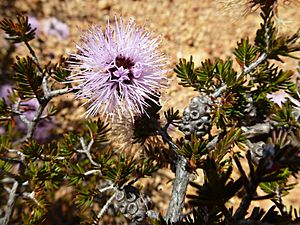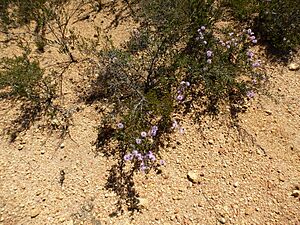Pink bottlebrush facts for kids
Quick facts for kids Pink bottlebrush |
|
|---|---|
 |
|
| Beaufortia schaueri growing near Ravensthorpe | |
| Scientific classification | |
| Genus: |
Beaufortia (plant)
|
| Species: |
schaueri
|
| Synonyms | |
|
Melaleuca jonesii Craven & R.D.Edwards |
|
Beaufortia schaueri, also known as the pink bottlebrush, is a cool plant from the Myrtaceae family, which is the same family as myrtle. This plant is special because it's endemic to the south-west part of Western Australia. This means it naturally grows only in that area!
It's a small, round bush with lots of tiny, packed leaves. In spring, it shows off many round, bright pink flowers. These flowers are easy to spot right at the ends of its branches.
What it Looks Like
The pink bottlebrush is a small, neat bush that usually grows up to about 1.5 meters (5 feet) tall. Its leaves are arranged in a cool way: they come in pairs, and each pair is at a right angle to the one below it. This makes them form four neat rows along the stems.
The leaves are about 10 millimeters (0.4 inches) long. They are thin and overlap each other, and if you cut one, it would look like a triangle or almost a circle.
The flowers are a beautiful bright pink or purple-pink color. They grow in almost perfectly round clusters at the tips of the branches. Even after the flowers bloom, the branches keep growing! Each flower has 5 small leaf-like parts called sepals and 5 petals. The most interesting part is that they have 5 groups of stamens (the parts that make pollen). Each group usually has 5 stamens, and they are joined together for about half their length.
You can see these lovely flowers from September to December. After the flowers fade, the plant produces woody seed pods, which are like little boxes holding the seeds.
How it Got its Name
The Beaufortia schaueri was first officially described in 1843. A scientist named Johannes Conrad Schauer gave it its name. He wrote about it in a special book called Dissertatio phytographica de Regelia, Beaufortia et Calothamno.
Where it Grows
You can mostly find the pink bottlebrush growing between the towns of Albany and Israelite Bay in Western Australia. It lives in several different natural areas, including the Avon Wheatbelt, Coolgardie, Esperance Plains, Jarrah Forest, and Mallee regions.
This plant likes to grow in sandy soils or soils that come from a type of rock called laterite. You'll often see it on flat plains or gentle slopes.
Is it Safe?
Good news! The Western Australian government's Department of Parks and Wildlife says that Beaufortia schaueri is "not threatened." This means there are plenty of these beautiful plants around, and they are not in danger of disappearing.


